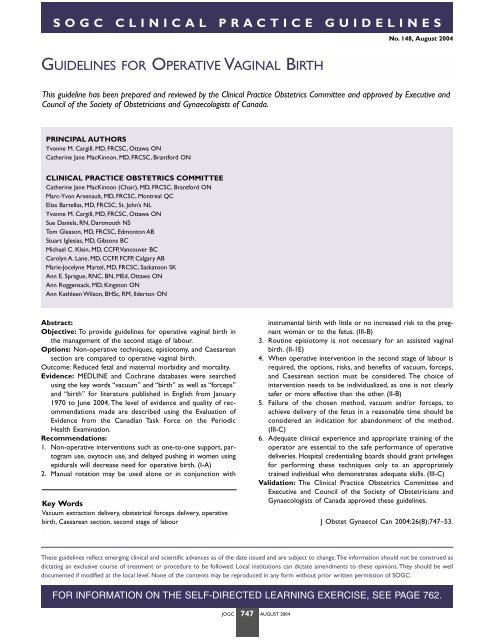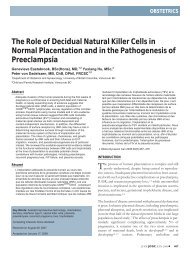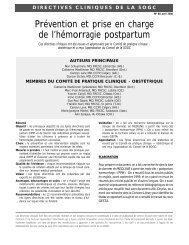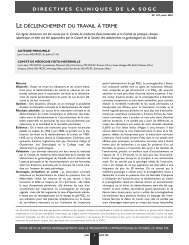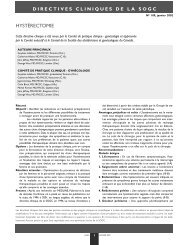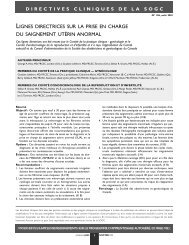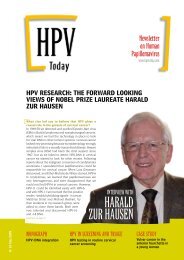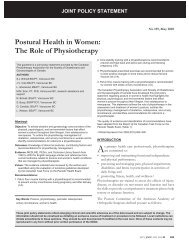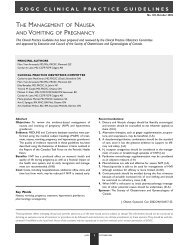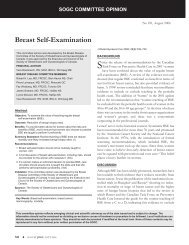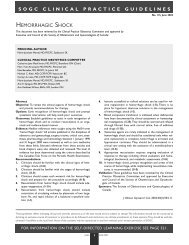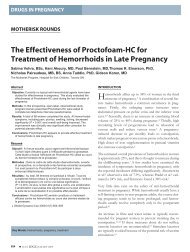Guidelines for operative vaginal birth - SOGC
Guidelines for operative vaginal birth - SOGC
Guidelines for operative vaginal birth - SOGC
Create successful ePaper yourself
Turn your PDF publications into a flip-book with our unique Google optimized e-Paper software.
<strong>SOGC</strong> CLINICAL PRACTICE GUIDELINES<br />
GUIDELINES FOR OPERATIVE VAGINAL BIRTH<br />
Abstract:<br />
Objective: To provide guidelines <strong>for</strong> <strong>operative</strong> <strong>vaginal</strong> <strong>birth</strong> in<br />
the management of the second stage of labour.<br />
Options: Non-<strong>operative</strong> techniques, episiotomy, and Caesarean<br />
section are compared to <strong>operative</strong> <strong>vaginal</strong> <strong>birth</strong>.<br />
Outcome: Reduced fetal and maternal morbidity and mortality.<br />
Evidence: MEDLINE and Cochrane databases were searched<br />
using the key words “vacuum” and “<strong>birth</strong>” as well as “<strong>for</strong>ceps”<br />
and “<strong>birth</strong>” <strong>for</strong> literature published in English from January<br />
1970 to June 2004. The level of evidence and quality of recommendations<br />
made are described using the Evaluation of<br />
Evidence from the Canadian Task Force on the Periodic<br />
Health Examination.<br />
Recommendations:<br />
1. Non-<strong>operative</strong> interventions such as one-to-one support, partogram<br />
use, oxytocin use, and delayed pushing in women using<br />
epidurals will decrease need <strong>for</strong> <strong>operative</strong> <strong>birth</strong>. (I-A)<br />
2. Manual rotation may be used alone or in conjunction with<br />
747<br />
JOGC AUGUST 2004<br />
No. 148, August 2004<br />
This guideline has been prepared and reviewed by the Clinical Practice Obstetrics Committee and approved by Executive and<br />
Council of the Society of Obstetricians and Gynaecologists of Canada.<br />
PRINCIPAL AUTHORS<br />
Yvonne M. Cargill, MD, FRCSC, Ottawa ON<br />
Catherine Jane MacKinnon, MD, FRCSC, Brant<strong>for</strong>d ON<br />
CLINICAL PRACTICE OBSTETRICS COMMITTEE<br />
Catherine Jane MacKinnon (Chair), MD, FRCSC, Brant<strong>for</strong>d ON<br />
Marc-Yvon Arsenault, MD, FRCSC, Montreal QC<br />
Elias Bartellas, MD, FRCSC, St. John’s NL<br />
Yvonne M. Cargill, MD, FRCSC, Ottawa ON<br />
Sue Daniels, RN, Dartmouth NS<br />
Tom Gleason, MD, FRCSC, Edmonton AB<br />
Stuart Iglesias, MD, Gibsons BC<br />
Michael C. Klein, MD, CCFP,Vancouver BC<br />
Carolyn A. Lane, MD, CCFP, FCFP, Calgary AB<br />
Marie-Jocelyne Martel, MD, FRCSC, Saskatoon SK<br />
Ann E. Sprague, RNC, BN, MEd, Ottawa ON<br />
Ann Roggensack, MD, Kingston ON<br />
Ann Kathleen Wilson, BHSc, RM, Ilderton ON<br />
Key Words<br />
Vacuum extraction delivery, obstetrical <strong>for</strong>ceps delivery, <strong>operative</strong><br />
<strong>birth</strong>, Caesarean section, second stage of labour<br />
instrumental <strong>birth</strong> with little or no increased risk to the pregnant<br />
woman or to the fetus. (III-B)<br />
3. Routine episiotomy is not necessary <strong>for</strong> an assisted <strong>vaginal</strong><br />
<strong>birth</strong>. (II-1E)<br />
4. When <strong>operative</strong> intervention in the second stage of labour is<br />
required, the options, risks, and benefits of vacuum, <strong>for</strong>ceps,<br />
and Caesarean section must be considered. The choice of<br />
intervention needs to be individualized, as one is not clearly<br />
safer or more effective than the other. (II-B)<br />
5. Failure of the chosen method, vacuum and/or <strong>for</strong>ceps, to<br />
achieve delivery of the fetus in a reasonable time should be<br />
considered an indication <strong>for</strong> abandonment of the method.<br />
(III-C)<br />
6. Adequate clinical experience and appropriate training of the<br />
operator are essential to the safe per<strong>for</strong>mance of <strong>operative</strong><br />
deliveries. Hospital credentialing boards should grant privileges<br />
<strong>for</strong> per<strong>for</strong>ming these techniques only to an appropriately<br />
trained individual who demonstrates adequate skills. (III-C)<br />
Validation: The Clinical Practice Obstetrics Committee and<br />
Executive and Council of the Society of Obstetricians and<br />
Gynaecologists of Canada approved these guidelines.<br />
J Obstet Gynaecol Can 2004;26(8):747–53.<br />
These guidelines reflect emerging clinical and scientific advances as of the date issued and are subject to change.The in<strong>for</strong>mation should not be construed as<br />
dictating an exclusive course of treatment or procedure to be followed. Local institutions can dictate amendments to these opinions. They should be well<br />
documented if modified at the local level. None of the contents may be reproduced in any <strong>for</strong>m without prior written permission of <strong>SOGC</strong>.<br />
FOR INFORMATION ON THE SELF-DIRECTED LEARNING EXERCISE, SEE PAGE 762.
OPERATIVE VAGINAL BIRTH<br />
Obstetrical-care providers frequently face dilemmas in the management<br />
of the second stage of labour. The decision as to<br />
whether or not a particular <strong>birth</strong> requires assistance and the<br />
choice and timing of any intervention must involve consideration<br />
of the risks of the potential techniques and the skills of the<br />
operator, as well as the urgency of the need to expedite the <strong>birth</strong><br />
process.<br />
Operative <strong>vaginal</strong> <strong>birth</strong> refers to <strong>for</strong>ceps- or vacuum-assisted<br />
delivery. Manual rotation, episiotomy, and, rarely, symphysiotomy<br />
can also be used to effect a <strong>vaginal</strong> <strong>birth</strong>. Caesarean<br />
section is the surgical alternative to <strong>operative</strong> <strong>vaginal</strong> <strong>birth</strong>.<br />
Experts often provide conflicting evidence <strong>for</strong> and against the<br />
use of these procedures. 1,2<br />
The literature discussing the use of vacuum and <strong>for</strong>ceps<br />
includes prospective randomized trials comparing the outcomes<br />
after <strong>for</strong>ceps- and vacuum-assisted <strong>birth</strong>. 3-6 These trials do not<br />
use the same inclusion criteria, the same instruments, or look<br />
at the same outcomes, making comparison of these 2 techniques<br />
difficult. Neonatal mortality and serious morbidity related to<br />
spontaneous <strong>vaginal</strong> <strong>birth</strong>, vacuum or <strong>for</strong>ceps, or Caesarean section<br />
have been reviewed in a large retrospective study. 7 None of<br />
these prospective 3-6 or retrospective 7 studies discuss specifics of<br />
the technique used <strong>for</strong> vacuum or <strong>for</strong>ceps procedures, the time<br />
required, or the criteria <strong>for</strong> abandonment of the procedure.<br />
The quality of evidence and classification of recommendations<br />
reported in this guideline have been described using the<br />
Evaluation of Evidence criteria outlined in the Report of the<br />
Canadian Task Force on the Periodic Health Exam (Table 1). 8<br />
INDICATIONS FOR OPERATIVE VAGINAL BIRTH<br />
Operative intervention in the second stage of labour may be indicated<br />
by conditions of the fetus or of the mother (Table 2). In<br />
Table 1<br />
Quality of Evidence Assessment 8 Classification of Recommendations 8<br />
The quality of evidence reported in these guidelines has been<br />
described using the Evaluation of Evidence criteria outlined in<br />
the Report of the Canadian Task Force on the Periodic Health<br />
Exam.<br />
I: Evidence obtained from at least one properly randomized<br />
controlled trial.<br />
II-1: Evidence from well-designed controlled trials without<br />
randomization.<br />
II-2: Evidence from well-designed cohort (prospective or<br />
retrospective) or case-control studies, preferably from<br />
more than one center or research group.<br />
II-3: Evidence obtained from comparisons between times or<br />
places with or without intervention. Dramatic results in<br />
uncontrolled experiments (such as the results of treatment<br />
with penicillin in the 1940s) could also be included in this<br />
category.<br />
III: Opinions of respected authorities, based on clinical<br />
experience, descriptive studies, or reports of expert<br />
committees.<br />
cases of non-reassuring fetal status, <strong>operative</strong> delivery may<br />
prevent hypoxic brain damage 9 or fetal death. 9 Maternal indications<br />
include congestive heart failure 9 or cerebral vascular mal<strong>for</strong>mations.<br />
9 Operative procedures may also be indicated <strong>for</strong><br />
inadequate progress in labour 9 ; in these cases, it is extremely<br />
important to ensure there is in fact adequate uterine activity. 10<br />
NON-OPERATIVE PRACTICES THAT DECREASE THE<br />
NEED FOR OPERATIVE BIRTH<br />
Several non-<strong>operative</strong> interventions have been shown to decrease<br />
the need <strong>for</strong> <strong>operative</strong> <strong>birth</strong>. One such intervention is the<br />
involvement of one-to-one <strong>birth</strong> attendants, who provide care<br />
during labour and <strong>birth</strong>. 11 Such attendants were described as<br />
experienced, continuously present, and able to provide physical<br />
and emotional support. 11 Hodnett11 assessed the role of the<br />
special support person in labour by reviewing 14 controlled trials,<br />
summarized in the Cochrane database, the results of which<br />
were all consistent despite a variety of obstetrical settings, hospital<br />
conditions, high- or low-risk pregnancies, and the differences<br />
in the professional training of the persons who provided<br />
the support. Using one-to-one <strong>birth</strong> attendants is a simple way<br />
to reduce the need <strong>for</strong> <strong>operative</strong> delivery. 11<br />
Monitoring the progress of labour and using oxytocin where<br />
progress is not adequate decreases the need <strong>for</strong> <strong>operative</strong> <strong>birth</strong>.<br />
Recommendations included in these guidelines have been<br />
adapted from the ranking method described in the Classification<br />
of Recommendations found in the Report of the Canadian Task<br />
Force on the Periodic Health Exam.<br />
A. There is good evidence to support the recommendation that<br />
the condition be specifically considered in a periodic health<br />
examination.<br />
B. There is fair evidence to support the recommendation that<br />
the condition be specifically considered in a periodic health<br />
examination.<br />
C. There is poor evidence regarding the inclusion or exclusion<br />
of the condition in a periodic health examination, but<br />
recommendations may be made on other grounds.<br />
D. There is fair evidence to support the recommendation that<br />
the condition not be considered in a periodic health<br />
examination.<br />
E. There is good evidence to support the recommendation that<br />
the condition be excluded from consideration in a periodic<br />
health examination.<br />
JOGC 748 AUGUST 2004<br />
Table 2. Indications <strong>for</strong> Operative Vaginal Birth<br />
Fetal<br />
• non-reassuring fetal status<br />
Maternal<br />
• medical indications to avoid valsalva (e.g., cerebral<br />
vascular disease, cardiac conditions)<br />
Inadequate progress<br />
• adequate uterine activity documented<br />
• no evidence of cephalopelvic disproportion<br />
• lack of effective maternal ef<strong>for</strong>t
In studies where a partogram is used, there is less oxytocin used<br />
and fewer <strong>operative</strong> <strong>birth</strong>s. 12 Oxytocin should be used be<strong>for</strong>e<br />
<strong>operative</strong> <strong>vaginal</strong> <strong>birth</strong> if labour is not progressing appropriately,<br />
and partograms should be used routinely. 10<br />
Flexibility in the management of the second stage of labour,<br />
including upright position, adequate analgesia, and delayed<br />
pushing if the woman does not have the urge to push, can also<br />
reduce the need <strong>for</strong> <strong>operative</strong> <strong>vaginal</strong> <strong>birth</strong>. A Canadian multicentred<br />
randomized study 13 demonstrated that women with<br />
epidurals were likely to have fewer <strong>operative</strong> interventions if<br />
they did not push in the second stage of labour until they had<br />
a strong urge to push or until 2 hours had passed. Flexibility<br />
with regard to time limits <strong>for</strong> the second stage of labour is also<br />
important. The rate of <strong>operative</strong> <strong>vaginal</strong> <strong>birth</strong> is reduced if the<br />
arbitrary time limit of 2 hours in the second stage of labour is<br />
abandoned when progress is being made. 13<br />
RECOMMENDATION<br />
1. Non-<strong>operative</strong> interventions such as one-to-one support,<br />
partogram use, oxytocin use, and delayed pushing<br />
in women using epidurals will decrease need <strong>for</strong> <strong>operative</strong><br />
<strong>birth</strong>. (I-A)<br />
MANUAL ROTATION<br />
Manual rotation is part of the art of obstetrics. The purpose of<br />
manual rotation is the same as <strong>for</strong> <strong>for</strong>ceps rotation: to turn the<br />
fetal head to an occiput anterior position, thus making the presenting<br />
diameter of the fetal head smaller. If rotation to an<br />
occiput anterior position is not occurring spontaneously, then<br />
manual rotation alone or in conjunction with an instrumental<br />
<strong>birth</strong> may facilitate <strong>vaginal</strong> delivery. Manual rotation can be<br />
used alone or it can be followed by <strong>for</strong>ceps or vacuum. Table 3<br />
outlines techniques <strong>for</strong> manual rotation. Although no studies<br />
exist on its effectiveness and potential complications, anecdotal<br />
evidence suggests that effectiveness is high, complications<br />
Table 3. Techniques <strong>for</strong> Manual Rotation<br />
Technique No. 1<br />
1. The entire hand is placed in the woman’s vagina with the<br />
palm up.<br />
2. The fetal head is flexed and slightly dislodged.<br />
3. The occiput is rotated anteriorly by pronation or supination<br />
of the <strong>for</strong>earm.<br />
4. The fetal head may need to be held in place <strong>for</strong> a few<br />
contractions or until the application of a vacuum or <strong>for</strong>ceps<br />
is completed.<br />
Technique No. 2<br />
1. The fingers may be placed along the lambdoid sutures.<br />
2. Using mild pressure and a dialling motion, the fetal head can<br />
be rotated to an occiput anterior position.<br />
3. The fetal head may need to be held in place <strong>for</strong> a few<br />
contractions or until the application of a vacuum or <strong>for</strong>ceps<br />
is completed.<br />
JOGC 749 AUGUST 2004<br />
are low, and the pain experienced is about the same as <strong>for</strong> cervical<br />
examination.<br />
RECOMMENDATION<br />
2. Manual rotation may be used alone or in conjunction<br />
with instrumental <strong>birth</strong> with little or no increased risk<br />
to the pregnant woman or to the fetus. (III-B)<br />
EPISIOTOMY<br />
Routine episiotomy has not been demonstrated to be an effective<br />
way to shorten the second stage of labour. 14 In the uncommon<br />
case where the perineum is preventing delivery, an<br />
episiotomy may expedite a <strong>vaginal</strong> <strong>birth</strong>. This has not been<br />
examined in any prospective studies.<br />
Episiotomy has also not been proven an essential part of an<br />
assisted <strong>vaginal</strong> <strong>birth</strong>, as it does not reduce and may increase the<br />
incidence of maternal trauma. 15 Midline episiotomies have been<br />
found to increase the risk of third- and fourth-degree tears in<br />
spontaneous deliveries 14 as well as <strong>operative</strong> deliveries. 15<br />
RECOMMENDATION<br />
3. Routine episiotomy is not necessary <strong>for</strong> an assisted <strong>vaginal</strong><br />
<strong>birth</strong>. (II-1E)<br />
INSTRUMENTAL VAGINAL BIRTH<br />
Instrumental <strong>vaginal</strong> <strong>birth</strong> involves use of the vacuum extractor<br />
or obstetric <strong>for</strong>ceps to allow the operator to increase the<br />
<strong>for</strong>ces along the pelvic curve. The vacuum applies suction and<br />
traction to an area on the scalp covered by the suction cup. 9,16<br />
Forceps cradle the parietal and malar bones of the fetal skull and<br />
apply traction to these areas, as well as laterally displacing maternal<br />
tissue. 9 The use of both instruments simultaneously causes<br />
compression of the fetal head. Table 4 outlines the prerequisites<br />
and contraindications to instrumental <strong>vaginal</strong> <strong>birth</strong>. Vacuum<br />
and <strong>for</strong>ceps deliveries are classified by the station of the leading<br />
bony point of the fetal head and the degree of rotation of the<br />
sagittal suture from the midline. Table 5 outlines the criteria <strong>for</strong><br />
different types of instrumental deliveries.<br />
Forceps and vacuum use have been compared in many studies.<br />
3,5-7,19,20 Johanson and Menon 3 included 10 such studies<br />
from the Cochrane database in a meta-analysis. Johanson and<br />
Menon found that vacuum is more likely to fail as the instrument<br />
of delivery than <strong>for</strong>ceps. Women randomized to the vacuum<br />
delivery groups, however, were less likely to require a<br />
Caesarean section. 3 The risk of maternal injury was greater in<br />
the <strong>for</strong>ceps groups. 3 Women who had a vacuum delivery had<br />
less severe lacerations than those who had a <strong>for</strong>ceps delivery as<br />
well as less perineal pain at 24 hours post-delivery. 3 Other studies<br />
demonstrated no difference in urinary incontinence or<br />
anal sphincter dysfunction after 5 years whether vacuum or
<strong>for</strong>ceps were used <strong>for</strong> <strong>operative</strong> <strong>vaginal</strong> <strong>birth</strong>. 3,5<br />
Complication rates to the neonate were similar in both the<br />
<strong>for</strong>ceps- and vacuum-delivered groups. 3 Cephalohematomas and<br />
retinal hemorrhages are more common in vacuum deliveries. 3<br />
External ocular injuries and facial nerve palsies are more common<br />
with <strong>for</strong>ceps deliveries. 3 Serious complications are rare <strong>for</strong> both<br />
<strong>for</strong>ceps and vacuum deliveries but can lead to neonatal<br />
death. 1,7,21,22 A large retrospective study of primigravid women<br />
in Cali<strong>for</strong>nia 7 found infants were no more likely to die be<strong>for</strong>e discharge<br />
when delivered by vacuum or <strong>for</strong>ceps than by spontaneous<br />
<strong>vaginal</strong> <strong>birth</strong>. They were less likely to die if delivered <strong>vaginal</strong>ly<br />
than by Caesarean section. A neonate delivered by 2 <strong>operative</strong><br />
interventions (i.e., Caesarean section following a failed vacuum<br />
attempt or <strong>for</strong>ceps attempt, or vacuum and <strong>for</strong>ceps <strong>birth</strong>) is more<br />
likely to have a serious injury than one delivered by any one of<br />
these interventions alone. 7 Indeed, a positive correlation exists<br />
between the number of <strong>operative</strong> interventions in the second stage<br />
of labour and the likelihood of death or intracranial injury. 7 Other<br />
research has demonstrated similar results. 17,23,24<br />
Fetal injuries have been attributed to delay between a failed<br />
<strong>operative</strong> <strong>vaginal</strong> delivery and a Caesarean section. 22 Most <strong>operative</strong><br />
deliveries, including the application of a vacuum, should<br />
Table 4. Instrumental Birth<br />
Prerequisites Contraindications<br />
• vertex presentation<br />
• cervix is fully dilated and the membranes ruptured<br />
• head is fully engaged<br />
• exact position of the head can be determined so<br />
proper placement of the instrument can be<br />
achieved<br />
• pelvis is deemed adequate<br />
• in<strong>for</strong>med consent must be obtained<br />
• appropriate analgesia is in place<br />
• maternal bladder has been emptied<br />
• adequate facilities and backup personnel are<br />
available<br />
• operator must have the knowledge, experience,<br />
and skill necessary to use the instruments and<br />
manage complications that may arise<br />
• backup plan<br />
Table 5. Criteria <strong>for</strong> Types of Instrument-Assisted Births 18<br />
JOGC 750 AUGUST 2004<br />
be considered a trial. Unless the practitioner is certain that an<br />
<strong>operative</strong> <strong>vaginal</strong> delivery is going to be successful, the possibility<br />
of failure needs to be anticipated. In these circumstances,<br />
an alternative plan that will result in a safe and expeditious <strong>birth</strong><br />
must be in place and implemented promptly if the planned<br />
<strong>operative</strong> <strong>birth</strong> is unsuccessful.<br />
Clear documentation is important throughout labour and<br />
<strong>birth</strong>. Table 6 lists the elements to include when documenting<br />
instrumental <strong>birth</strong>.<br />
Table 6. Elements Required <strong>for</strong> Documentation of<br />
Instrumental Birth<br />
• indication <strong>for</strong> intervention<br />
• record of discussion with the woman of the risks, benefits, and<br />
options<br />
• position and station of the fetal head, as well as how it was<br />
assessed (i.e., <strong>vaginal</strong>ly and/or abdominally)<br />
• amount of moulding and caput present<br />
• assessment of maternal pelvis<br />
• assessment of fetal heart rate and contractions<br />
• number of attempts and ease of application of vacuum or<br />
<strong>for</strong>ceps<br />
• duration of traction and <strong>for</strong>ce used<br />
• description of maternal and neonatal injuries<br />
Relative<br />
• unfavourable attitude of fetal head<br />
• rotation >45° from occiput anterior or occiput<br />
posterior (vacuum)<br />
• mid-pelvic station<br />
• fetal prematurity. There is a small retrospective<br />
study reviewing the outcome of deliveries of<br />
infants 1500 g to 2500 g. No difference was<br />
found in Apgar scores, umbilical pH, or<br />
intraventricular hemorrhage when comparing<br />
vacuum extraction with controls who delivered<br />
spontaneously. 17<br />
Absolute<br />
• non-vertex or brow<br />
• unengaged head<br />
• incomplete cervix dilation<br />
• clinical evidence of cephalopelvic<br />
disproportion<br />
• fetal coagulopathy<br />
Outlet • fetal scalp visible without separating the labia<br />
• fetal skull has reached the pelvic floor<br />
• sagittal suture is in the anteroposterior diameter or right or left occiput anterior or posterior<br />
position (rotation does not exceed 45°)<br />
• fetal head is at or on the perineum<br />
Low • leading point of the skull is at station plus 2 cm or more and not on the pelvic floor<br />
Two subdivisions: (a) rotation of 45º or less, (b) rotation more than 45º<br />
Mid • fetal head is engaged<br />
• leading point of the skull is above station plus 2 cm
VACUUM<br />
While the rate of <strong>operative</strong> <strong>vaginal</strong> <strong>birth</strong> has remained stable<br />
over the last decade (1991–2001), the rate of vacuum use has<br />
increased from 6.8 to 10.6%. 25 When used properly, the vacuum<br />
technique (Table 7) may facilitate a <strong>vaginal</strong> delivery from<br />
an outlet or very low station with an application of brief duration<br />
and minimal traction <strong>for</strong>ces. 25<br />
Vacuum cups can be metal or plastic, rigid or soft. Randomized<br />
studies 4 report rigid cups to be more likely to result in<br />
<strong>vaginal</strong> <strong>birth</strong> than soft cups, but they are more likely to cause<br />
scalp trauma. Be<strong>for</strong>e vacuum can be recommended as a rotational<br />
instrument, evidence of its safety <strong>for</strong> this purpose must<br />
be established. Rotation may occur with descent of the vertex,<br />
but when actively used to rotate the fetus, torsion can result in<br />
severe injury to the scalp. 22<br />
It has been repeatedly shown that maternal injury is less frequent<br />
and less extensive with the use of vacuum compared to<br />
<strong>for</strong>ceps. 3,6,19,20 Maternal complications of vacuum delivery<br />
include cervical lacerations, severe <strong>vaginal</strong> lacerations, <strong>vaginal</strong><br />
hematomas, and third- and fourth-degree tears. 3,9 A maternal<br />
third- and fourth-degree laceration rate of 17% was reported<br />
with vacuum use in Quebec from 1991/1992 through<br />
1995/1996. 20 This rate is significantly higher than at an unassisted<br />
delivery (odds ratio [OR], 3.9; confidence interval [CI],<br />
3.8–4.1) but lower than with <strong>for</strong>ceps use (OR, 0.5; CI,<br />
0.5–0.5). 20 An inspection <strong>for</strong> lacerations should be conducted<br />
after every vacuum delivery.<br />
Fetal and neonatal complications of vacuum use vary in<br />
severity from mild scalp lacerations 4,9 to severe subaponeurotic<br />
hemorrhage 4,9,21,22 or intracranial hemorrhage and<br />
death. 4,9,21,22 A Cochrane review of randomized trials found an<br />
odds ratio of 2.38 (CI, 1.6–3.37) <strong>for</strong> a cephalohematoma occurring<br />
following vacuum use compared to that following <strong>for</strong>ceps<br />
Table 7. Vacuum-Assisted Birth<br />
JOGC 751 AUGUST 2004<br />
use. 4 Subaponeurotic hemorrhages, skull fractures, and intracranial<br />
hemorrhages were not reviewed in these studies. 4 A historical<br />
cohort 20 from 1991/1992 and 1995/1996 found the<br />
incidence of cephalohematoma with vacuum delivery to be<br />
12.8%. The incidence of intracranial hemorrhage was 0.1%,<br />
which is higher than that <strong>for</strong> spontaneous deliveries but not<br />
higher than that <strong>for</strong> <strong>for</strong>ceps. The rate of subaponeurotic hemorrhage<br />
was not recorded. 20 The American College of Obstetricians<br />
and Gynecologists estimates the incidence of neonatal<br />
death or serious injury related to vacuum <strong>birth</strong> to be 1 in 45<br />
455 vacuum extractions. 1<br />
It is the experience of members of the Clinical Practice<br />
Obstetrics Committee that vacuum deliveries have been per<strong>for</strong>med<br />
when the cervix is not fully dilated and the head is not<br />
engaged. This may be considered only when the benefits significantly<br />
outweigh the risks and when there is no viable alternative.<br />
FORCEPS<br />
Forceps use in Canada has decreased over the last decade from<br />
11.2% in 1991 to 6.8% in 2001. 25 Techniques <strong>for</strong> applying <strong>for</strong>ceps<br />
vary with the type of <strong>for</strong>cep being used. Detailed descriptions<br />
can be found in obstetrical textbooks 9 and the ALARM<br />
(Advances in Labour and Risk Management) course. 27 Practice<br />
may take place on inanimate models, and clinical experience<br />
should be gained under the supervision of an experienced operator<br />
be<strong>for</strong>e one applies them independently. Table 8 outlines<br />
important application principles and procedures as well as possible<br />
complications.<br />
Maternal and fetal complications can occur with <strong>for</strong>ceps<br />
use. A retrospective study 20 in Quebec reported third- or fourthdegree<br />
perineal lacerations to occur at a rate of 31% with <strong>for</strong>ceps<br />
<strong>birth</strong>. 20 This rate is similar to that found in other research. 28<br />
Application Procedure Potential Complications<br />
• Prior to application, check that the vacuum is working and the pressure dial is<br />
not delivering >500–600 mm Hg. Pressure greater than this does not improve<br />
outcome and may result in an increased risk of complications. 24,26<br />
• With the vacuum suction off, apply the center of the cup to the occiput, 2 cm<br />
anterior to the posterior fontanelle. The sagittal suture should be centered<br />
under the vacuum. The vacuum cup should be checked to ensure it includes<br />
no maternal tissue.<br />
• Apply suction to the scalp. Check that there are no maternal tissues within the<br />
vacuum cup.<br />
• Traction is applied with a contraction and the axis of traction follows the<br />
pelvic curve.<br />
• The safe parameters <strong>for</strong> maximum number of pulls and the maximum time of<br />
use are not well established. Most (76%–96%) deliveries are effected within<br />
four contractions. 16 If delivery has not occurred after four contractions, the<br />
intended method of delivery should be reassessed.<br />
• Descent should be evaluated after each contraction. Lack of descent with<br />
appropriate technique is evidence of cephalopelvic disproportion.<br />
• Pop-offs should be avoided. Pop-offs lead to rapid<br />
compression/decompression <strong>for</strong>ces. No studies have examined injuries related<br />
to repeated pop-offs.<br />
• maternal lacerations<br />
• fetal scalp lacerations and bruising<br />
• facial nerve palsy<br />
• cephalohematoma<br />
• subaponeurotic hemorrhage<br />
• skull fractures<br />
• intracranial hemorrhage<br />
• retinal hemorrhage<br />
• hyperbilirubinemia
Table 8. Forceps-Assisted Birth<br />
Application Principles and Procedure Potential Complications<br />
• Be familiar with the instrument being used.<br />
• Use finger-strength pressure when applying <strong>for</strong>ceps.<br />
• Rotation within one plane can only be done with <strong>for</strong>ceps without a pelvic<br />
curve.<br />
• When checking the application:<br />
(a) the posterior fontanelle should be located midway between the sides of the<br />
blades, with the lambdoid sutures equidistant from the <strong>for</strong>ceps blades and<br />
one finger-breadth above the plane of the shanks.<br />
(b) the sagittal suture must be perpendicular to the plane of the shanks<br />
throughout its length.<br />
(c) the fenestration of the blades should be barely felt and the amount of<br />
fenestration felt on each side should be equal. With a solid blade, no more<br />
than a fingertip should be able to be inserted between the blade and the<br />
fetal head.<br />
In the neonate, facial lacerations occurred at a rate of 1%. 6,19<br />
Neurologic sequelae in the <strong>for</strong>m of facial nerve palsy in the Quebec<br />
study 20 occurred at a rate of 0.5%, 5 times higher than with<br />
a vacuum <strong>birth</strong> (relative risk [RR], 5; CI, 2.5–5). The incidence<br />
of cephalohematoma was 1% and intracranial hemorrhage<br />
0.1%. 20 The use of protective covers over <strong>for</strong>ceps has been<br />
found to decrease superficial skin lacerations. 29<br />
CAESAREAN SECTION<br />
There is a recent trend to go to Caesarean section in the second<br />
stage without due consideration of <strong>operative</strong> <strong>vaginal</strong> delivery.<br />
However, when <strong>operative</strong> <strong>vaginal</strong> <strong>birth</strong> is unsuccessful, felt to<br />
be unsafe, or is unacceptable to the woman, Caesarean section<br />
is the appropriate choice. Caesarean sections also have a risk of<br />
serious complications. Babies delivered by Caesarean section<br />
have more respiratory difficulty, including that requiring ventilation.<br />
30 Caesarean section increases the risk in subsequent<br />
pregnancies of uterine rupture, 31 which can lead to fetal death<br />
or serious fetal hypoxic injury. 22,31 Caesarean section also<br />
increases the risk of placenta previa, 32 placental abruption, 32<br />
and invasive placental disease. 32<br />
Maternal risk from Caesarean section includes increased<br />
maternal mortality. In women who deliver by Caesarean section,<br />
maternal mortality is 4-fold that of the maternal population<br />
that delivers <strong>vaginal</strong>ly. 33 The woman is at increased<br />
anaesthetic risk, particularly due to aspiration, 31 and risk of<br />
increased blood loss, 32 infection, 32 venous thromboembolus, 32<br />
and surgical injury to bladder and bowel. 32<br />
Use of vacuum or <strong>for</strong>ceps may be necessary at the time of<br />
Caesarean section.<br />
RECOMMENDATIONS<br />
4. When <strong>operative</strong> intervention in the second stage of<br />
labour is required, the options, risks, and benefits of vacuum,<br />
<strong>for</strong>ceps, and Caesarean section must be considered.<br />
The choice of intervention needs to be individualized,<br />
as one is not clearly safer or more effective than the<br />
other. (II-B)<br />
5. Failure of the chosen method, vacuum and/or <strong>for</strong>ceps,<br />
to achieve delivery of the fetus in a reasonable time<br />
should be considered an indication <strong>for</strong> abandonment<br />
of the method. (III-C)<br />
6. Adequate clinical experience and appropriate training<br />
of the operator are essential to the safe per<strong>for</strong>mance of<br />
<strong>operative</strong> deliveries. Hospital credentialing boards<br />
should grant privileges <strong>for</strong> per<strong>for</strong>ming these techniques<br />
only to an appropriately trained individual who demonstrates<br />
adequate skills. (III-C)<br />
SUMMARY<br />
When second stage of labour problems are going to affect<br />
maternal or fetal well-being, first consideration should be given<br />
to non-<strong>operative</strong> intervention. When non-<strong>operative</strong> interventions<br />
have been maximized, the options and risks of <strong>operative</strong><br />
<strong>vaginal</strong> <strong>birth</strong> compared to Caesarean section must be considered.<br />
Whether or not <strong>operative</strong> <strong>vaginal</strong> <strong>birth</strong> is appropriate <strong>for</strong><br />
women in the second stage of labour is a complex decision with<br />
many risks to balance, including maternal well-being, fetal wellbeing,<br />
and the availability of facilities and personnel. The most<br />
appropriate intervention needs to be chosen on an individual<br />
basis, within the context of each woman’s unique circumstances.<br />
REFERENCES<br />
JOGC 752 AUGUST 2004<br />
• maternal lacerations<br />
• minor external ocular trauma<br />
• retinal hemorrhage<br />
• fetal skull fractures<br />
• facial nerve palsies<br />
• cephalohematomas<br />
• subaponeurotic hemorrhages<br />
• intracranial hemorrhages<br />
• scalp lacerations<br />
1. American College of Obstetricians and Gynecologists. Delivery by<br />
vacuum extraction. ACOG Committee Opinion No. 208.Washington<br />
(DC): ACOG; September 1998.<br />
2. Chalmers JA, Chalmers I.The obstetric vacuum extractor is the instrument<br />
of first choice <strong>for</strong> <strong>operative</strong> <strong>vaginal</strong> delivery. Br J Obstet Gynaecol<br />
1989;96(5):505–6.<br />
3. Johanson RB, Menon V.Vacuum extraction vs. <strong>for</strong>ceps <strong>for</strong> assisted <strong>vaginal</strong><br />
delivery (Cochrane Review). In:The Cochrane Library, Issue 1 2003.<br />
Ox<strong>for</strong>d: Update Software.<br />
4. Johanson R, Menon V. Soft versus rigid vacuum extractor cups <strong>for</strong>
assisted <strong>vaginal</strong> delivery. In:The Cochrane Library, Issue 3 2000. Ox<strong>for</strong>d:<br />
Update Software.<br />
5. Johanson RB, Heycock E, Carter J, Sultan AH,Walklate K, Jones PW.<br />
Maternal and child health after assisted <strong>vaginal</strong> delivery: five-year follow<br />
up of a randomized controlled study comparing <strong>for</strong>ceps and ventouse.<br />
Br J Obstet Gynaecol 1999;106(6):544–9.<br />
6. Johanson RB, Rice C, Doyle M, Arthur J, Anyanwu L, Ibrahim A, et al.<br />
A randomised prospective study comparing the new vacuum extractor<br />
policy with <strong>for</strong>ceps delivery. Br J Obstet Gynaecol 1993;100:524–30.<br />
7. Towner, Castro M, Eby-Wilkens F, Gilbert W. Effect of mode of delivery<br />
in nulliparous women on neonatal intracranial injury. N Engl J Med<br />
1999;341(2):1709–14.<br />
8. Woolf SH, Battista RN, Angerson GM, Logan AG, Eel W. Canadian Task<br />
Force on the Periodic Health Exam. Ottawa: Canada Communication<br />
Group; 1994. p. xxxvii.<br />
9. Cunningham FG, Gant NF, Leveno KJ, Gilstrap LC, Hauth JC,Wenstrom<br />
KD.Williams Obstetrics. New York: McGraw-Hill; 2001.<br />
10. Saunders NJ, Spiby H, Gilbert L, Fraser RB, Hall JM, Mutton PM, et al.<br />
Oxytocin infusion during second stage of labour in primiparous women<br />
using epidural analgesia: a randomized double-blind placebo-controlled<br />
trial. BMJ 1989;299(6713):1423–6.<br />
11. Hodnett FD. Caregiver support <strong>for</strong> women during child<strong>birth</strong>. In:The<br />
Cochrane Library, Issue 1 2003. Ox<strong>for</strong>d: Update Software.<br />
12. World Health Organization Maternal Health and Safe Motherhood<br />
Program.World Health Organization partograph in the management of<br />
labour. Lancet 1994;343:1399–401.<br />
13. Fraser W, Marcoux S, Krauss I, Douglas J, Goulet C, Boulvan M. Multicenter<br />
randomized controlled trial of delayed pushing <strong>for</strong> nulliparous<br />
women in the second stage of labor with continuous epidural analgesia.<br />
Am J Obstet Gynecol 2000;182:1165–72.<br />
14. Myers-Helfgott MG, Helfgott AW. Routine episiotomy in modern<br />
obstetrics: should it be per<strong>for</strong>med? Obstet Gynecol Clin North Am<br />
1999;26(2):305–25.<br />
15. Steed H, Corbett T, Mayes D.The value of routine episiotomy in <strong>for</strong>ceps<br />
deliveries. J Soc Obstet Gynaecol Can 2000;22(8):583–6.<br />
16. Williams, MC.Vacuum-assisted delivery. Clin Perinatol<br />
1995:22(4):933–52.<br />
17. Morales R, Adair CD, Sanchez-Ramos L, Gaudier FL.Vacuum extraction<br />
of preterm infants with <strong>birth</strong> weights of 1500–2499 grams. J Reprod<br />
Med 1995;40(2):127–30.<br />
18. American College of Obstetricians and Gynecologists. Operative <strong>vaginal</strong><br />
delivery. ACOG Practice Bulletin No. 17.Washington (DC): ACOG;<br />
June 2000.<br />
JOGC 753 AUGUST 2004<br />
19. Meyer L, Mailloux J, Maroux S, Blanchet P, Meyer F. Maternal and neonatal<br />
morbidity in instrumental deliveries with the Kobayashi vacuum<br />
extractor and low <strong>for</strong>ceps. Acta Obstet Gynecol Scand 1987;6:643–7.<br />
20. Wen S, Liu S, Kramer M, Maroux S, Ohlsson, Sauve R, et al. Comparison<br />
of maternal and infant outcomes between vacuum extraction and <strong>for</strong>ceps<br />
deliveries. Am J Epidemiol 2001;153(2):103–7.<br />
21. Obstetrical Care Review Committee. Sixth annual report of the Obstetrical<br />
Care Review Committee <strong>for</strong> the Office of the Chief Coroner <strong>for</strong><br />
Ontario. January–December 1999.<br />
22. Obstetrical Care Review Committee. Eighth annual report of the<br />
Obstetrical Care Review Committee <strong>for</strong> the Office of the Chief Coroner<br />
<strong>for</strong> Ontario. January–December 2001.<br />
23. Gardella C,Taylor M, Benedetti T, Hitti J, Critchlow C.The effect of<br />
sequential use of vacuum and <strong>for</strong>ceps <strong>for</strong> assisted <strong>vaginal</strong> delivery on<br />
neonatal and maternal outcomes. Am J Obstet Gynecol 2001;185:<br />
896–902.<br />
24. Sadan O, Ginath S, Gomel A, Abramov D, Rotmensch S, Boaz M, et al.<br />
What to do after a failed attempt of vacuum delivery? Eur J Obstet<br />
Gynecol Reprod Biol 2003;107(2):151–5.<br />
25. Health Canada. Canadian perinatal health report 2003. Ottawa (ON):<br />
Minister of Public Works and Government Services Canada; 2003.<br />
26. Lucas MJ.The role of vacuum extraction in modern obstetrics.<br />
Clin Obstet Gynecol 1994;37:794–805.<br />
27. Society of Obstetricians and Gynaecologists of Canada. ALARM<br />
(Advances in Labour and Risk Management) course in<strong>for</strong>mation. Available<br />
on-line at .<br />
28. Johnson JH, Figueroa R, Garry D, Elimian A, Maulik D. Immediate maternal<br />
and neonatal effects of <strong>for</strong>ceps- and vacuum-assisted deliveries.<br />
Obstet Gynecol 2004;103(3):513–8.<br />
29. Johanson R. Obstetrical <strong>for</strong>ceps pad designed to reduce trauma. Review<br />
No. 07086. In: Cochrane Pregnancy and Child<strong>birth</strong> Database, 1995.<br />
Ox<strong>for</strong>d: Update Software.<br />
30. Hook B, Kiwi R, Amim SB. Neonatal morbidity after elective repeat<br />
Cesarean section and trial of labor. Pediatrics 1997;100:348–55.<br />
31. Martel MJ, MacKinnon CJ. <strong>Guidelines</strong> <strong>for</strong> <strong>vaginal</strong> <strong>birth</strong> after Caesarean<br />
section. J Obstet Gynaecol Can 2004;26.<br />
32. Jackson N, Paterson-Brown S. Physical sequelae of Caesarean section.<br />
Best Pract Res Clin Obstet Gynaecol 2001;15(1):49–61.<br />
33. Lil<strong>for</strong>d RJ, van Coeverden de Groot HA, Moore PJ, Bingham P. The relative<br />
risks of Caesarean section (intrapartum and elective) and <strong>vaginal</strong><br />
delivery: a detailed analysis to exclude the effects of medical disorders<br />
and other acute pre-existing physiological disturbances. Br J Obstet<br />
Gynaecol 1990;97(10):883–92.


